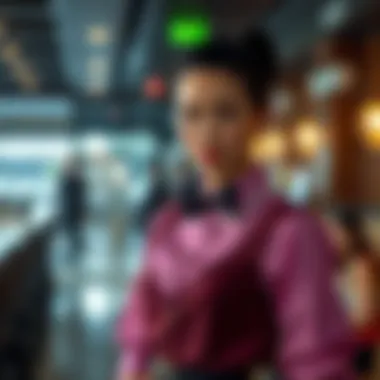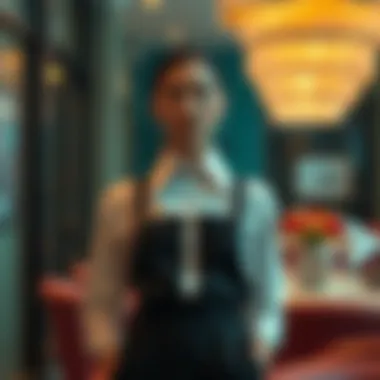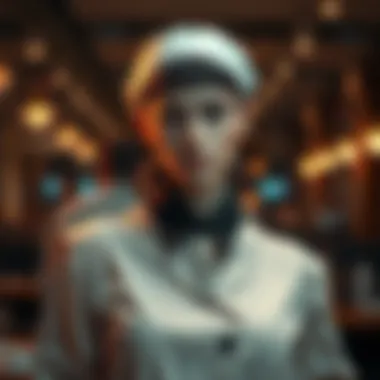The Aesthetics and Impact of Server Outfits in Hospitality


Intro
In a world where first impressions hold significant weight, the attire worn by servers has evolved into a symbol of both style and service. The aesthetics of server outfits not only reflect personal taste but also encompass broader cultural narratives that shape the way we perceive dining experiences. This article sheds light on the intricate interplay between outfit choices and their implications for the hospitality industry, addressing everything from historical trends to present-day practices.
The evolution of server outfits presents a fascinating study in contrasts, as they move from simplistic designs to more visually striking ensembles that are, at times, drenched in cultural significance. Here, we will unfold the layers of this narrative by exploring current fashion trends and how they balance aesthetics with the demanding nature of server roles.
Clothing Trends Analysis
Current Trends in Seasonal Fashion
The cyclical nature of fashion sees server outfits breaking free from a singular identity, adapting vibrant hues and experimental designs significantly shaped by seasonal trends. For example, spring collections might showcase lighter fabrics, pastel colors, and floral prints, aligning with the rejuvenation theme associated with the season. Conversely, fall/winter collections often shift toward earthy tones and textured layers, embodying warmth and comfort.
"Fashion is about dreaming and making other people dream." – Donatella Versace
However, the aspect of functionality cannot be overlooked. Outfits need to be more than just visually appealing; they must prioritize comfort and ease of movement. Woven materials that offer breathability while still holding a polished appearance have become essential.
Iconic Styles Through Decades
Diving into history, the outfit worn by servers has reflected societal values and norms of its time. In the 1950s, for instance, the classic white apron over dark attire epitomized service etiquette. Fast forward to the 1970s and the rise of casual dining sparked a shift towards casual yet stylish outfits, introducing denim and patterned dress shirts into the equation.
More recently, social media has created a platform for showcasing creativity, leading to a surge in gaming and pop culture references in server attire. With outfits cleverly designed to reflect brand aesthetics or even seasonal themes, it seems that each decade revitalizes the dialogue around server uniforms.
As fashion touches various points of influence, it’s essential to analyze how each era’s cultural cues shaped the profession, often showcasing societal trends and taste in a distinctive manner.
Styling Tips and Techniques
Essential Tips for Wardrobe Versatility
Maximizing the impact of server outfits often hinges on wardrobe versatility. Here are a few tips:
- Choose a Base Color: Start with a solid base color; black and navy are timeless choices that pair well with a variety of accessories.
- Accessorize Wisely: A statement belt or unique shoes can elevate a basic outfit, adding personality without overwhelming a professional image.
- Prioritize Fit: Ill-fitting clothes can detract from an otherwise appealing presentation. Tailored outfits create a polished appearance.
Layering Techniques for Effortless Looks
Layering outfits is not just for warmth; it can also create visual interest. Here are a couple of smart strategies:
- Blend Textures: Pair a fitted collared shirt with a loose-fitting cardigan or jacket to create depth.
- Use Patterns Sparingly: If your base is a bold pattern, offset it with solid layers to maintain visual balance in a professional setting.
The ability to adapt clothing according to personal style while adhering to functional expectations is paramount in promoting a cohesive image for servers.
Prelude to Server Outfits
In the bustling world of the hospitality industry, server outfits play a critical role that extends far beyond mere appearance. These ensembles are not just uniform but a visual language that conveys professionalism, brand identity, and even personal style. The significance of server attire lies in its ability to influence customer experiences and employee morale, a point that becomes progressively apparent the deeper one digs into this topic.
Importance of Server Outfits
Server outfits represent the intersection of fashion, function, and culture. Outfits are crafted to serve specific purposes, be it comfort during long shifts or an aesthetic that aligns with a restaurant’s theme. They act as a first impression, subtly shaping the patrons' perception of quality and service even before the first interaction occurs. For example, a sleek, tailored outfit in a fine dining establishment may evoke a sense of sophistication, while a casual, whimsical attire in a diner could suggest a laid-back, approachable atmosphere. Understanding these nuances is integral to deciphering the broader impacts of server outfits on consumer behavior.
Additionally, these outfits can be a source of pride for the servers themselves. When done right, they can provide a sense of belonging and individuality within a team context. The right attire allows servers to express their personal style while adhering to the standards of their workplace. This balance fosters an environment that respects both the brand and personal expression, making the topic all the more relevant.
Key Elements of Server Outfits
- Brand Alignment: Outfits must resonate with the restaurant’s overall theme or brand image.
- Comfort and Functionality: Fabrics and fit should account for mobility and comfort during shifts.
- Trends and Cultural Influence: Modern styles often reflect societal changes and cultural preferences.
In summary, server outfits are more than just clothing; they are part of a complex framework that influences interactions in the hospitality sector. By considering their definition, characteristics, and historical context, we can better appreciate the art and science behind these carefully chosen ensembles, setting the stage for a deeper exploration of their impact on both servers and customers.
Cultural Perceptions of Server Attire
When discussing the role of server outfits, one cannot overlook the significant impact of cultural perceptions surrounding attire. The clothing worn by servers in the hospitality industry often carries deeper meanings, reflecting societal values, norms, and expectations. This section will dive into the cultural interpretations of server attire, emphasizing the ways it influences not just the clientele's experience but also the identity and self-perception of the servers themselves. Understanding this cultural lens is vital for designers and stylists aiming to create outfits that resonate on multiple levels within this vibrant industry.


Influence of Media and Pop Culture
The media and pop culture play a pivotal role in shaping how server outfits are perceived. Movies, TV shows, and advertisements frequently depict servers in specific ways, creating lasting impressions on the audience. For instance, the portrayal of servers in films like "Waiting" or the iconic cafe scenes from "Friends" often emphasizes either the playfulness or the seductiveness of server attire. These representations can alter public expectations about how servers should look and behave, reinforcing certain stereotypes that may not necessarily fit reality.
"Our clothes can whisper— or shout— who we are or who we could be to the world."
On social media platforms, visually driven content allows trends to spread faster than wildfire. Hashtags like #ServerStyle make it easy for users to explore diverse aesthetics, showcasing everything from casual denim to chic, tailored uniforms. As influencers and celebrities sport different styles within these roles, it sends ripples throughout the hospitality industry. Servers may feel compelled to adopt these trends, feeling either pressure to conform or, conversely, a desire to stand out from the crowd.
Regional Variations in Style
Regional differences can also leave their mark on server attire, bringing local culture and unique flair to the forefront. In cities with distinct cultural backgrounds, like New Orleans, outfits might showcase vibrant colors and patterns, reflecting the town's festive spirit. Conversely, in more formal settings such as upscale restaurants in New York City, you might find servers donning sleek black garb, projecting an image of professionalism that aligns with the high-end dining experience.
Key points of regional variations include:
- Local Tradition: Certain places have traditions tied to their cuisine, affecting how servers dress.
- Climate Considerations: Hot and humid regions call for breathable fabrics, whereas colder climates may favor layering techniques.
- Historical Influences: Areas like the Midwest may carry remnants of farming or rustic aesthetics even into their dining culture, influencing server outfits to reflect a blend of functionality and style.
Fashion Trends in the Hospitality Industry
In today's fast-paced world of hospitality, fashion trends play a significant role in shaping the environment, the experience of guests, and the identity of staff. Examining trends in server outfits is more than just a glance at the latest styles; it encompasses understanding how these trends influence workplace dynamics, customer interactions, and overall brand perception. The outfits worn by servers provide not only a visual representation of a venue's ethos but also act as a crucial element in fostering a connection between the customer and the service.
As the industry evolves, the emphasis on style and function is crucial. Designers and hospitality businesses must consider both the aesthetic appeal and the practical needs of those who wear these outfits. Functionality needs to complement fashion; for example, breathable fabrics that withstand the rigors of the restaurant floor while also appearing polished and trendy are in high demand. More importantly, these fashion trends serve as a tool for restaurants to brand themselves uniquely, reflecting their culinary style and the ambiance they wish to create.
Evolving Styles Over Time
The trajectory of server fashion throughout the years tells a story of adaptation and response to numerous factors, such as shifts in societal values, advancements in materials technology, and consumer expectations. Back in the day, server outfits were typically limited to a standard uniform, often consisting of white shirts, black pants, and aprons. However, with changing perceptions of professionalism and the desire for individualized expression, the range of acceptable server attire has expanded significantly.
For instance, restaurants today might opt for vintage-inspired dresses, contemporary streetwear elements, or even bold graphic tees combined with tailored slacks. This blend of styles mirrors the broader fashion landscape, where mash-ups and hybrids reign supreme. To illustrate, a modern sushi restaurant might incorporate traditional Japanese aesthetics through kimono-inspired tops paired with sleek, minimalist trousers, representing a thoughtful nod to heritage while aligning with contemporary tastes.
Moreover, the democratization of fashion through platforms like Instagram and Pinterest allows for increased awareness and influence. Emerging designers now cater to niche markets, creating unique outfits that can represent specific culinary themes or target demographics, such as vegan eateries or gastropubs.
Emergence of Specialty Outfits
In recent years, we've seen the emergence of specialty outfits tailored for distinct settings within the hospitality sector. These outfits go beyond basic uniforms, aiming to encapsulate the essence of a dining experience or service model. For example, casual dining establishments may lean towards chic, laid-back looks—think denim aprons over colorful, playful tops—while fine dining establishments may require more formal attire, like bespoke jackets or intricately designed dresses.
This shift has led to the introduction of themed outfits designed specifically for events, festivals, or holidays, which allows for creativity and personal expression. A lively taco joint might dress servers in bright, festive prints to enhance the overall dining experience, creating a vibrant atmosphere that resonates with the menu.
Furthermore, specialty outfits can also focus on sustainability, showcasing eco-friendly materials as a response to customer awareness about environmental issues. This approach not only meets consumer expectations but also aligns with a broader movement toward ethical consumption, allowing restaurants to position themselves effectively within their markets.
"The outfits servers wear tell a story—one that speaks to the restaurant's mission and identity, bridging the gap between service and experience."
Materials and Design Considerations
When discussing server outfits, the materials and design choices become crucial not just for aesthetic purposes but for their overall role in daily operations. The interplay between fabric and design significantly influences the success of server attire in various hospitality settings. These factors can affect how servers experience their work environment, how customers perceive their professionalism, and how the restaurant brand is represented. It’s not just about looking good, but about feeling comfortable and functional, which directly impacts the quality of service.
Fabric Choices for Comfort and Durability
Selecting the right fabric is akin to choosing the backbone of a well-performing server outfit. One must weigh durability against comfort. Fabrics like polyester and cotton blends are popular choices; they are sturdy yet breathable. The longevity of an outfit can affect the business’s bottom line, as frequent replacements can become a costly affair. Moreover, incorporating materials such as spandex enhances mobility, allowing servers to dash between tables with grace.
Considerations for fabric choices include:
- Breathability: Outfits made from breathable fabrics can keep servers comfortable during busy shifts.
- Stain Resistance: Stain-repellent fabrics can save time and effort in maintenance, which is pivotal in a fast-paced environment.
- Flexibility: Stretchable materials ensure that outfits can accommodate various body movements, which is essential for achieving optimal service during peak hours.
Using eco-friendly materials is also gaining traction, especially among younger clientele who value sustainability. Fabrics like Tencel and recycled polyester not only provide durability but allow servers to feel good about their attire's impact on the environment.
Impact of Design on Functionality
Design intricacies play a critical role that extends beyond aesthetic appeal. An outfit can look stunning but, if it hampers movement, its purpose is defeated. Thoughtful design ensures functionality aligns with visual attractiveness. For instance, pocket placement is more than just a decorative element; it influences how quickly a server can navigate through tasks, such as carrying extra pens or stashing a notepad.


Key design aspects to ponder include:
- Fit: Tailored outfits enhance appearance and also affect comfort. A well-fitted design can prevent wardrobe malfunctions that could distract both server and customer.
- Layering Options: In environments with varying temperatures, designs that allow for layering can adapt to both kitchen heat and dining area coolness.
- Visual Cohesion: The overall design should reflect the establishment's brand, with colors and styles that resonate with its identity. This visual cohesion becomes integral to marketing and customer expectation.
"When the outfit works for you, that’s when the magic happens in the hospitality scene."
For further exploration on the impact of fashion within hospitality, you might find resources like Wikipedia, Britannica and insights on discussions in Reddit enlightening.
The Psychological Impact of Outfits on Servers
The topic of psychological impact stemming from server outfits is of considerable importance within the hospitality industry. Attire does not merely serve a functional purpose; it plays a crucial role in shaping both the identity of the servers and their interactions with customers. When servers embrace outfits that resonate with their personal style, this can lead to enhanced job satisfaction and a stronger connection with their roles. Conversely, outfits that feel restrictive or misaligned with their self-image might hinder performance and morale.
Understanding how these dynamics operate can help restaurant owners, managers, and designers craft uniforms that truly empower workers while also meeting business objectives.
Self-Expression through Attire
One cannot underestimate the power of clothing as a medium for self-expression. In the service sector, servers often have limited autonomy over their uniforms. Yet, when given the opportunity, many will personalize their attire to reflect their unique tastes or personalities. For example, a server who works in a chic urban café might choose to accessorize a standard black dress with bold jewelry or colorful shoes, signaling their individual flair without straying from the dress code.
This form of self-expression can have several psychological benefits:
- Boosting Confidence: When servers feel that their outfit reflects who they are, it can bolster their self-esteem. This sense of pride translates into more personable interactions with customers.
- Creating Connection: A connection can be fostered when servers dress in a way that resonates with the vibe of the establishment. This authenticity can make customers feel more at ease, creating a welcoming atmosphere.
- Encouraging Creativity: Allowing a small amount of input on outfits can stimulate creativity and innovation among staff, which, in turn, may lead to higher job satisfaction.
"Clothes aren't just fabric; they're part of our identity and how we choose to present ourselves to the world."
Effects on Job Performance and Morale
The correlation between server attire and job performance can't be ignored. Studies show that when employees are satisfied with their clothing choices, there’s a positive ripple effect on overall workplace morale. Here are some factors that show how server outfits can impact performance:
- Comfort Level: Attire that is comfortable and functional allows servers to perform tasks more efficiently. For instance, breathable fabrics can make a shift feel less strenuous, enabling them to give their best service without distraction.
- Professional Appearance: A polished appearance not only positively influences customers’ perceptions but can also enhance the server's self-perception. This boosts morale and promotes a professional approach to service.
- Team Cohesion: When uniforms are chosen thoughtfully for their aesthetic appeal and functional design, it fosters a sense of unity among the staff. Workers often feel they belong to something greater than themselves, improving teamwork and harmony.
Customer Reactions to Server Attire
The way customers respond to server attire significantly shapes their experience in a hospitality setting. Proper attire can create an immediate impression, influencing everything from a customer's mood to their decision-making. It’s essential to investigate how these reactions impact the overall dining experience and the business’s bottom line. When customers walk into a restaurant or bar, they are subconsciously assessing not only the menu but also the ambiance and the staff's attire. This section delves into the dual aspects of this relationship and highlights its importance in modern service industry environments.
Influencing Customer Behavior
Customer behavior is remarkably sensitive to visual cues, and server outfits are among the most powerful of these cues. Studies indicate that well-tailored and appealing outfits can enhance perceptions of service quality. When servers present themselves in stylish and appropriate attire, it often translates into customer trust and comfort. For instance, a study by the Cornell University School of Hotel Administration revealed that guests rated service in upscale restaurants higher when servers wore formal attire compared to casual outfits.
There are several ways in which server attire influences customer behavior:
- Emotional Response: Often, customers feel a certain way based on what they see. A server in a smart outfit can evoke confidence, creating a sense of relaxation or excitement to try new dishes.
- Brand Association: Outfits can reinforce a restaurant or bar's brand identity. For example, a vintage diner’s servers might wear retro uniforms to reflect the nostalgic atmosphere, which could enhance the customer’s overall experience.
- Social Triggers: Attire can serve social interaction cues. Formal outfits might spark conversational ease, while casual clothing can create a laid-back vibe, influencing how patrons relate to the staff and each other.
Servers, therefore, carry the weight of not only personal expression but also business representation in their clothing choices. When they wear something that aligns with the establishment's image, they can effectively guide the emotional compass of their clientele.
Perceptions of Professionalism
The attire of servers also affects perceptions of professionalism, which can significantly impact a customer’s experience. Customers often judge a restaurant’s credibility based on how its staff is dressed. An impeccably dressed server can imply a higher level of service and care.
Research suggests that when servers look professional, it promotes a favorable image of the establishment. Visually appealing outfits can communicate several key attributes of the business:
- Competency: A polished appearance signals that the server is knowledgeable and capable. This expectation extends to their ability to recommend dishes and handle customer concerns effectively.
- Attention to Detail: When servers wear carefully curated outfits, it often reflects the establishment's attention to detail in all areas, from menu choices to overall service quality.
- Trustworthiness: Customers are more likely to feel comfortable in a setting where the staff’s professionalism is portrayed through their attire. A well-dressed server can be perceived as reliable, enhancing their willingness to engage with the server and share personal preferences or dietary restrictions.
"Dress is a silent ambassador; it conveys more than words. A well-chosen outfit can set the tone for an entire dining experience."
Navigating the Balance Between Style and Professionalism
In the hospitality realm, the intersection of style and professionalism plays a pivotal role in shaping both employee identity and customer perception. Striking the right balance ensures that server outfits not only reflect the establishment's vibe but also uphold a level of professionalism that instills trust and confidence in customers. This section delves into the crucial elements involved in navigating this delicate balance, exploring how thoughtful choices can yield tangible benefits.


Establishing Dress Codes
Dress codes serve as the backbone for maintaining a consistent aesthetic across service teams. An effective dress code balances creativity while setting professional parameters that guide employees on what is deemed appropriate. More than just a list of dos and don'ts, a well-crafted dress code can enhance team unity and reinforce brand identity.
Consider these factors when establishing a dress code:
- Inclusivity: Each outfit should cater to various body types and cultural backgrounds. A one-size-fits-all approach will often lead to discomfort among staff.
- Functionality: Attire must allow servers to perform their tasks efficiently. For instance, tight dresses hinder movement, while overly loose clothing presents safety hazards.
- Aesthetic Consistency: The design should resonate with the restaurant's theme. A fine-dining establishment may opt for tailored suits, while a casual eatery might lean towards comfortable yet chic aprons.
Implementing a dress code that resonates with employees while satisfying professional expectations can lead to enhanced morale and workplace satisfaction. After all, when servers feel good in what they wear, that positivity often reflects in their service.
Finding Common Ground for Employers and Employees
Both parties come to the table with their own sets of interests. Employers want a polished look that promotes the brand, while employees seek comfort and an avenue for self-expression through attire. Finding common ground here is essential for a harmonious workplace environment.
To harmonize these perspectives, consider the following:
- Open Dialogue: Employers should engage employees in conversations about dress codes, allowing them to share their needs and preferences. This dialogue fosters a sense of ownership over the outfit choices.
- Trial Periods: Allow for a testing phase where different outfits can be worn and evaluated. Gathering feedback during this period can help businesses adjust their standards based on real-life experiences.
- Recognition of Individual Style: Employers might incorporate a system where employees can choose from a range of approved outfits, enabling individual expression while maintaining a cohesive brand image.
As the fabric of hospitality grows ever more intricate, the balance between stylishness and professionalism remains paramount. By weaving flexibility into dress codes and establishing a collaborative environment, both servers and employers can flourish in their respective roles.
Future Directions in Server Fashion
The world of server fashion is at a turning point. As we look ahead, it’s vital to understand how the intersection of style, sustainability, and technology can shape the future of attire in the hospitality industry. This segment highlights notable trends, challenges, and opportunities that arise from adopting sustainable practices and integrating innovative materials. With these considerations, we can better appreciate how server outfits will evolve to meet both aesthetic preferences and functional needs.
Sustainable Fashion in the Workplace
Sustainability is not just a buzzword; it’s becoming a prerequisite in various sectors, including hospitality. With increasing awareness of environmental impacts, hospitality businesses must reflect this in their server attire. Choices about fabric production, manufacturing processes, and disposal practices are gaining urgency.
- Eco-Friendly Materials: Natural fibers, recycled polyester, and organic cotton are gaining popularity. Brands are considering their supply chain from start to finish to minimize harm to the environment.
- Durability and Longevity: Furnishing servers with outfits built to withstand wear and tear not only reduces waste but also cuts costs in the long run. Outfits designed for longevity can become a symbol of a brand's commitment to sustainability.
- Ethical Production: As customers become conscious of the brands they support, server outfits that are ethically produced resonate more. This means ensuring fair labor practices, fair wages, and safe working conditions in garment factories.
These efforts can bolster a restaurant’s image, attracting environmentally aware patrons while making a positive impact on the planet. Moreover, when servers feel proud of their attire’s ethical origins, it reflects in their overall morale and service.
Technology and Smart Fabrics
Advancements in textile technology are steering the future of server fashion toward functionality without sacrificing style. With a blend of traditional fabric and cutting-edge technology, smart fabrics are becoming a focal point in designing server outfits. Here are some innovations to watch:
- Moisture-Wicking and Breathable Fabrics: Servers often navigate busy environments, leading to physical exertion and varying temperatures. Fabrics that wick moisture and allow for breathability can enhance comfort during long shifts.
- Stain-Resistant Treatments: Outfits treated with advanced stain-resistance techniques can save time and money, making the maintenance of attire much easier for establishments. This technology helps keep server outfits looking fresh even under the strains of a hectic restaurant atmosphere.
- Temperature Regulation: Imagine materials that can adapt to the wearer's body temperature! Composite fabrics are being developed to assist in temperature control, offering great relief for servers working under bright lights in bustling kitchens.
These technological advancements have the potential to reshape not only how server outfits are designed, but also how they are experienced, leading to outfit evolution that caters directly to the demands of service roles.
"The future of server fashion lies at the convergence of sustainability, ethics, and technological advancements, redefining what it means to dress for success in hospitality."
As these trends unfold, the hospitality industry must remain agile, adapting to new standards and consumer preferences, ensuring that server attire remains both functional and fashionable. The road ahead is not just about how servers dress, but how their attire reflects larger societal values and trends.
Epilogue
The examination of server outfits is not just a superficial glance at fabric and styles; it’s a deep dive into the undercurrents of culture, performance, and identity within the hospitality industry. This article has shed light on the various facets that shape server attire, emphasizing the importance of aesthetics along with functionality. It highlights that a well-thought-out outfit does more than dress a person; it symbolizes professionalism, influences customer perceptions, and affects employee morale.
Understanding server outfits can foster greater engagement between employers and employees. With attention to comfort and design, businesses can attract talent that feels valued and confident in their roles. When servers feel good in what they're wearing, it shows in their performance. It sets a tone that can elevate the dining experience for customers, creating a cycle of satisfaction.
"Fashion is the armor to survive the reality of everyday life." – Bill Cunningham. This sentiment captures the essence of server outfits that balance style with practicality, reinforcing the idea that attire can be a source of empowerment.
Importantly, the journey does not end here. As societies evolve, so too will the context in which these outfits are worn. The implications of cultural shifts, sustainability, and technological advancements will continue to influence how we view and create server attire. Thus, revisiting this topic periodically to keep pace with changes is essential for those in the field of fashion.
Key Takeaways
- Server outfits play a crucial role in conveying professionalism and enhancing customer experience.
- Careful consideration of materials impacts both the comfort of servers and the perception of patrons.
- Balancing aesthetics and functionality ensures that outfits are not only visually appealing but also practical for daily tasks.
- Emotional well-being and self-expression through attire can significantly enhance job performance.
- The fashion of server outfits is fluid, necessitating ongoing dialogue between employers and employees.
Looking Ahead
As we move into the future, several key trends loom over the horizon of server attire. The rise of sustainable fashion is one such movement that can no longer be overlooked. Many establishments are beginning to prioritize eco-friendly materials and ethical labor practices, setting the scene for a revolution in how server outfits are sourced and constructed.
Furthermore, technology is playing its part. Smart fabrics that regulate temperature or wickers away moisture are becoming more commonplace. Innovations like these will not only improve comfort for servers but also can influence the visual appeal and overall design of their uniforms.







